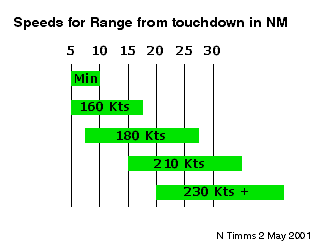Speed Control
I use these approximate speeds when vectoring arrivals for instrument approaches at Hong Kong International Airport.

I vary them for unusual weather or traffic situations but for most purposes these work well. Please let me know if these are not appropriate for the type of aircraft that you fly. I am open to advice.
Application
I usually progressively reduce speeds inside 30 NM and plan to end with 160 Kts to 4 NM.
I will use ‘minimum safe approach speed’ if I need to fix a gap quickly. This is rarely necessary, would usually be within 10 NM from touchdown, and obviously effects following aircraft.
I often use ‘..or greater’: the issued speed is the minimum necessary for sequencing but that a higher speed is still acceptable. You can slow your aircraft when you want but not below my issued speed. When I need a slower fixed speed then I will issue it but it gives you the option of staying faster if desired.
The phrase ‘..or less’ is really only ever appropriate for the last aircraft in the sequence: if you get it, you know where you are.
Speed Control Problems?
Speed control is a basic ATC tool. Approach Radar Controllers usually use speed control when sequencing arriving aircraft. ATC and Crews will resolve problems by each stating requirements and promptly announcing changes.
ATC
ATC is not always correct; after all, most of us were once human. I may sometimes issue an inappropriate speed instruction for your particular aircraft or configuration. Let me know what speed you can accept.
Crews
Unexpected speed reductions cause many sequencing difficulties at Hong Kong. If you need to reduce speed then let me know as soon as possible so that I can adjust the sequence.
Fly assigned fixed speeds as a fixed speed. There is not an implied ‘..or less’. Speed instructions include something like ‘…or greater’ or ‘..or less’ if appropriate.
System
Hong Kong approach and departure procedures include speed limits. These restrict the radius of turn for aircraft flying procedures so that aircraft remain sufficiently inside Hong Kong airspace, or for obstacle clearance. These speed limits do not apply when you receive radar vectors or if ATCassigns you a speed. The 250 Kts limit below 10,000 ft always applies unless cancelled by an ATC speed instruction.
Please do not waste time asking for minor speed changes (5 Kt) from your assigned speed; ATC will not notice this difference and it will not have much effect anyway.
Why do ATC speed us up then slow us down again?
To position your aircraft relative to others in a sequence.
To integrate your aircraft in a sequence ATC will sometimes request a speed higher than the sequence speed until you get to the correct relative position. Then we'll request a speed change so that the speed of your aircraft matches the speed of the one ahead. It can work the other way round as well.
Analogy:
You are driving your car on a slip road that joins a busy highway. You can see a gap in the traffic but it's the only one for a while and you'll have to slow quite a bit to fit in the next gap.
You decide to keep your speed the same or accelerate slightly and join the highway traffic in the first gap. This works well but the highway traffic flow is slower than the speed that you needed to fit in the gap. You then slow your speed to match the speed of the vehicle ahead and stay a safe distance behind.
There are of course some added complications for aircraft operations:
- aircraft configuration
- the speeds are not constant - usually slowing closer to the airfield
- other events require an new ATC plan
- an aircraft ahead just slowed unexpectedly
- you just slowed unexpectedly
- ATC don't always plan effectively or apply the plan correctly
- you may not see an obvious sequence order (ATC will have a cunning plan